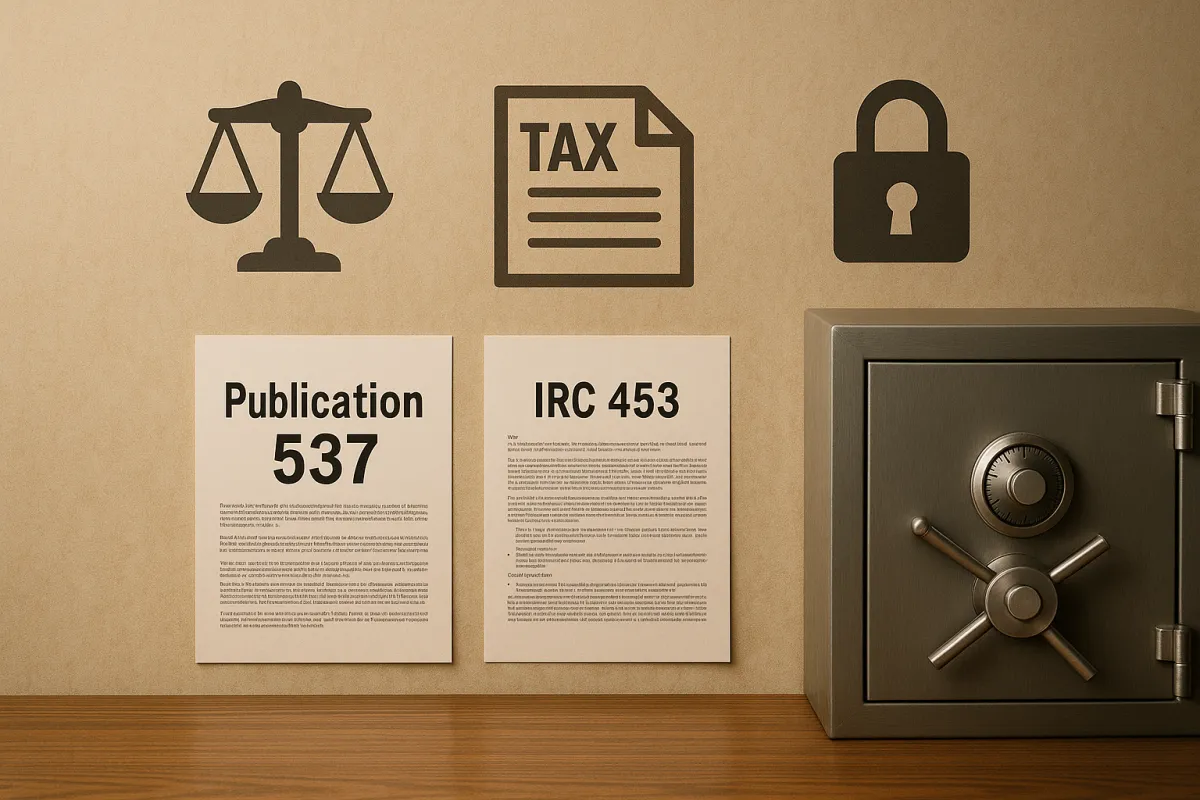Q-Exchange Blog

Where Does "537" Come From in 537 Installment Sale Trust?
Where Does "537" Come From in 537 Installment Sale Trust?
What Is the 537 Installment Sale Trust?
The 537 Installment Sale Trust (537 IST) is a strategic, IRS-compliant tax deferral mechanism that allows individuals to sell appreciated assets—such as businesses, real estate, or investment holdings—without immediately triggering capital gains tax. Instead of receiving a lump sum from the sale, the proceeds go into a trust, and the seller receives payments over time through a secured promissory note. This approach spreads the tax liability across multiple years and enables the funds inside the trust to grow through investments in the meantime.
One key feature of the 537 IST is the use of a third-party trustee, ensuring that the seller does not have direct access to or control over the trust assets. This prevents what’s known as “constructive receipt,” which would otherwise make the transaction taxable in the year of sale.
Where Does "537" Come From?
The term “537” in 537 Installment Sale Trust is directly derived from IRS Publication 537, which explains how the installment method of reporting works for sales where payments are received over multiple years. While the legal foundation of installment sales is Internal Revenue Code (IRC) Section 453, the step-by-step, practical guidance that real-world taxpayers and professionals follow is outlined in Publication 537.
This naming choice helps distinguish this trust structure from other methods and aligns with how many professionals in the financial industry communicate compliance. So, although “453” is the underlying statute, “537” is the trusted resource that makes it accessible and actionable—hence the name “537 IST.”
Why the 537 IST is Fully Legal and IRS-Compliant
There has been increasing scrutiny from the IRS regarding installment sale strategies, particularly abusive practices like monetized installment sales that violate IRS regulations. In IR-2023-65, the IRS specifically named such abusive structures on its Dirty Dozen list, warning taxpayers of non-compliant schemes that involve loans against trust assets or circular cash flows.
The 537 IST is different and avoids all these red flags. Here's why:
No Loans from the Trust: The seller is prohibited from taking loans against the trust or the secured note. This ensures it never qualifies as a monetized installment sale.
Independent Trustee Involvement: A neutral third party, not the seller, controls the trust (through IST Admin Services), maintaining proper separation and avoiding constructive receipt.
Taxed When Principal Withdrawn: Any withdrawals from the principal are taxed as capital gains, ensuring proper tax recognition and eliminating loopholes.
Transparent Documentation: Each transaction is reviewed and approved by CPAs and attorneys to ensure every aspect is fully above board.
At Q-1031.com, compliance isn’t just a goal—it’s a core philosophy. We routinely speak with IRS representatives to validate our practices, have never faced an audit, and provide full support—including legal defense—if an audit ever occurs. In contrast to “gray area” strategies, the 537 IST is built on decades of proven law, professional execution, and a clear paper trail.
Compliance and Abuse: Lessons from IR-2023-65
In recent years, the IRS has issued strong warnings against abusive installment sale arrangements, most notably through IR-2023-65, which outlines tactics that fall into the category of tax evasion. These include monetized installment sales, where sellers indirectly access funds through backdoor loans or related-party transactions—practices that distort the intention of the tax code.
The IRS places these schemes on its Dirty Dozen list for good reason: they involve constructs that appear to defer taxes but are, in substance, cash-outs. These arrangements may result in audits, retroactive tax liabilities, interest penalties, and even criminal charges in egregious cases.
The 537 IST, however, is not a monetized installment sale. It explicitly prohibits loans from the trust, ensures independent trustee oversight, and clearly taxes any principal withdrawals. By adhering to the rules laid out in IRS Publication 537 and IRC Section 453, it keeps the strategy fully compliant and transparent—avoiding any features that resemble abusive tax shelters.
The Compliance Checklist for 537 ISTs
To remain legally sound and IRS-compliant, a 537 Installment Sale Trust must strictly follow several key principles. Here’s what a proper 537 IST looks like:
Third-Party Trustee: An independent, professional fiduciary (not the seller) manages the trust. This ensures there is no conflict of interest or constructive receipt.
No Immediate Access to Funds: The seller does not receive proceeds directly. Instead, funds go into the trust and are paid out over time through an installment note.
Secured Promissory Note: The seller holds a secured note backed by the trust's assets, giving them financial security without owning or controlling the assets.
Withdrawals Are Taxed: Any distributions of income or principal are reported as taxable events. There’s no way to shield income or defer tax indefinitely.
Proper Legal Documentation: Every step is documented and vetted by legal and tax professionals to ensure regulatory alignment.
These safeguards are not optional—they are essential. At Q-1031.com, we uphold every one of these standards on every transaction.
How the 537 IST Differs from Abusive Models
It’s easy to confuse various tax-deferral strategies, but not all installment sales are created equal. Here’s how the 537 IST stands apart from problematic and illegal models:
No Circular Flow of Funds: Abusive models often cycle the proceeds back to the seller through loans or intermediaries. The 537 IST doesn’t allow this.
No Related-Party Control: The trustee must be unrelated to the seller to maintain IRS-required independence and arm's-length status.
No Hidden Promissory Loopholes: Some schemes disguise loans as installment payments. The 537 IST is a transparent structure with real payments and clear tax implications.
IRS Communication: Q-1031.com proactively communicates with IRS representatives to validate compliance and stays updated on evolving guidance.
Audit-Ready Structuring: The trust is built with full audit preparedness, backed by tax attorneys, CPAs, and documented IRS technical memorandums (TAMs).
In short, the 537 IST is everything an abusive installment model is not. It’s transparent, regulated, independently managed, and properly taxed. That’s why Q-1031.com has never had a client audited over this strategy and is ready to support you if the IRS ever inquires.
Key Benefits of a 537 Installment Sale Trust
The 537 IST isn’t just a tax deferral tool—it’s a comprehensive financial strategy that offers multiple benefits:
Capital Gains Tax Deferral: By spreading payments over time, sellers delay their tax liability, keeping more capital working for them in the trust.
Investment Growth: The funds inside the trust are professionally invested, often generating returns that outpace the tax burden incurred upon distribution.
Liquidity and Flexibility: Sellers can receive scheduled income or request principal withdrawals (with taxes due), providing optionality unavailable in other deferral strategies.
Estate Planning Advantages: The secured promissory note can be passed to heirs, potentially with a step-up in basis, making this a useful generational wealth vehicle.
No 1031 Timeline Pressure: Unlike a 1031 exchange, there’s no strict identification or reinvestment window, making the IST far more flexible.
With these benefits, the 537 IST proves to be more than a stopgap—it’s a strategic financial tool for maximizing after-tax outcomes.
Q-1031.com: A Leader in Compliant 537 IST Transactions
Q-1031.com has been at the forefront of compliant installment sale trust structuring for over two decades. With more than 3,500 successfully executed transactions, we have helped clients across the U.S. legally defer taxes, build wealth, and secure financial futures without triggering IRS scrutiny.
Here’s what sets Q-1031 apart:
Experience: Over 20 years of specialization in tax deferral strategies.
Compliance-First Philosophy: Every trust is built to IRS standards, reviewed by CPAs and attorneys.
Education-Based Approach: We train professionals and communicate directly with IRS agents to remain updated and transparent.
Audit Support Included: In the rare event of an audit, our tax and legal team steps in—at no extra charge.
Secure Process: We use a third-party trustee (IST Admin Services) and implement multiple layers of verification, including user approval on investments.
We don’t operate in legal gray zones. We don’t hide from audits. We operate with the full knowledge and confidence that what we’re doing is 100% IRS-compliant.
Case Studies and Success Stories
Let’s look at a few real-world examples that highlight the power and compliance of the 537 IST:
Business Exit Strategy: A business owner in California sold their company for $4.2 million. Through the 537 IST, they deferred immediate taxes, invested the full principal, and generated a stable income stream of $300,000 annually while planning for retirement.
Real Estate Portfolio Liquidation: A landlord sold a 12-property portfolio and used the trust to stagger payments over 15 years. Not only did they defer capital gains taxes, but the trust allowed reinvestment into diversified assets, enhancing both liquidity and returns.
Generational Planning: A family used the IST to pass down proceeds from a commercial property sale. Their heirs now receive steady income, and the secured note received a favorable step-up in basis.
Each of these cases followed strict IRS compliance rules, involved third-party trustees, and ensured that no funds were accessed prematurely or improperly. These are not hypotheticals—they are the direct result of Q-1031’s proven process.
Conclusion
The “537” in 537 Installment Sale Trust originates from IRS Publication 537, which explains how to legally defer capital gains through structured installment payments under IRC Section 453. Although it’s often confused with or compared to questionable tax shelters, the 537 IST is fundamentally different.
With strict rules such as third-party trustee management, a prohibition on loans, and full taxation on withdrawals, this trust operates in full daylight—not the gray zone. At Q-1031.com, we’ve completed over 3,500 transactions without a single IRS audit, thanks to our commitment to regulatory compliance and professional integrity.
Whether you’re selling a business, real estate, or any appreciated asset, the 537 IST offers a smarter, safer, and fully legal way to defer taxes, grow your wealth, and protect your legacy.
Want to compare selling your asset traditionally, with a 537 Installment Sale Trust, and using a 1031 exchange? Get a free Revenue Estimator Report HERE for a direct comparison.
Ready to Start your Tax-Deferral Journey?
Schedule a 15-minute phone call for further questions or getting started.
Nothing on this site should be interpreted to state or imply that past results are an indication of future performance. This site does not constitute a complete description of our investment services and is for informational purposes only. It is in no way a solicitation or an offer to sell insurance, annuities, securities or investment advisory services except, where applicable, in states where we are registered or where an exemption or exclusion from such registration or licensing exists. Information throughout this internet site, whether stock quotes, charts, articles, or any other statements regarding market or other financial information, is obtained from sources which we, and our suppliers believe reliable, but we do not warrant or guarantee the timeliness or accuracy of this information. Neither our information providers nor we shall be liable for any errors or inaccuracies, regardless of cause, or the lack of timeliness of, or for any delay or interruption in the transmission thereof to the user. All investments involve risk, including foreign currency exchange rates, political risks, different methods of accounting and financial reporting, and foreign taxes.

